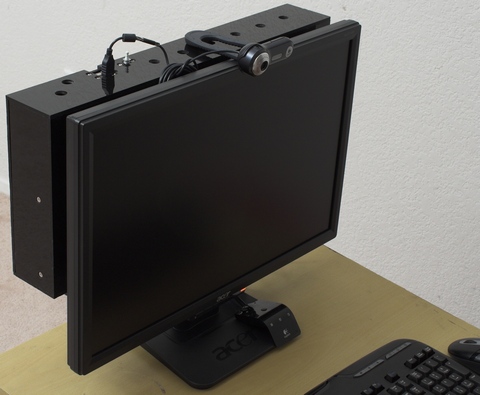The polycarbonate all-in-one 22" LCD PC

The last time I built a wooden all-in-one 19" LCD PC, my family wanted it in the kitchen and my mother wanted it in hers. To keep everyone happy, I built my mother another one (pictured above and below) out of 3/16th inch jet-black polycarbonate which makes the chassis look like the material from a grand piano. The result was something that was so glossy that I can probably shave in it, but I'm almost afraid to touch it and get finger prints all over it. Needless to say, she is very pleased with her new space saving computer. [See photo gallery.]
Cutting this material was fairly simple with wood-cutting and drilling tools. Just be careful to slow down on the table saw so you don't chip the polycarbonate. I had initially avoided putting in vent holes in the back but the CPU fan and the PSU fan dynamically ramped up in RPM because of the increasing temperature and caused some noise. Once the 4 holes were put in the back, the CPU fan stayed at lower RPM and remained fairly silent even if I stress loaded the CPUs.
This time I mounted the on/off switch up top along with two USB ports which makes it easy to access and comes in handy for the webcam. I just wished I had a webcam that did away with the cable and just had a down-facing USB port so I can just plug it in right on top of the case. The other USB port is convenient for plugging other devices such as USB memory sticks or other devices I want sitting on top of the chassis.
As usual with these slim custom chassis, I used a slim 1.75" 1U Sparkle SPI220LE 80 Plus 220 watt power supply. The idle power consumption on this computer is 43 watts and 63 watt under peak CPU loads generated by WPrime. The motherboard is an ECS 945GCT-M which came bundled with an Intel Celeron 430 CPU (Conroe-L 1.8 GHz single-core) I got at Fry's for $70. I put in an Intel Core 2 Duo E2140 dual-core 1.6 instead and kept the lower-profile CPU fan which came with the Celeron 430. That lower profile fan came in real handy since it fit inside my 3" thick chassis which is even less space inside because of the thickness of the walls. This chassis has plenty of room for additional devices such as a slim optical slot-loaded drive.
This 3" thick custom chassis is no where near as thin as commercial all-in-one computers, but it makes up for it in flexibility since you can use any monitor of your choice and the price is right ($500) for those who are willing to build it. Those all-in-one boxes from Dell, Gateway, Sony, and even the iMac (20" model) have typical TN (Twisted Nematic) LCD screens with poor color and viewing angles. This computer also uses a TN type display but the next one I get will be the $300 24" Soyo with an MVA panel from Office Depot.
I probably could have made this half an inch thinner if I wanted to and even thinner if I used a low-profile CPU fan. Theoretically this could be 1.75" thick if this were made out of metal. The sides of the polycarbonate were glued together with acrylic cement which is incredibly strong if you can apply it correctly (I used a make thin flat makeup brush). I literally picked up the entire computer from just the edges of the polycarbonate walls and it held perfectly fine even though the edges are only 3/16th of an inch wide.
You can see the power plug reflected in the polycarbonate back. One thing I wish I had was a belt sander to smooth out and polish the edges more. It not only makes a better finish but it makes it easier to glue the joints together.
The webcam comes in handy for Skype. This is the older Logitech Quickcam Fusion so it can't be used for high-quality video mode in Skype but still looks decent. The keyboard and mouse is the Logitech EX110 ($30-$40) which uses 27 MHz with shorter range but it isn't susceptible to Wi-Fi interference.
From the front, you can't see the computer behind the display at all which is the whole point. This computer takes no more space than the display and the wiring is all self contained which avoids cable clutter.
Note: This information is also available as a PDF in the TechRepublic downloads library.
